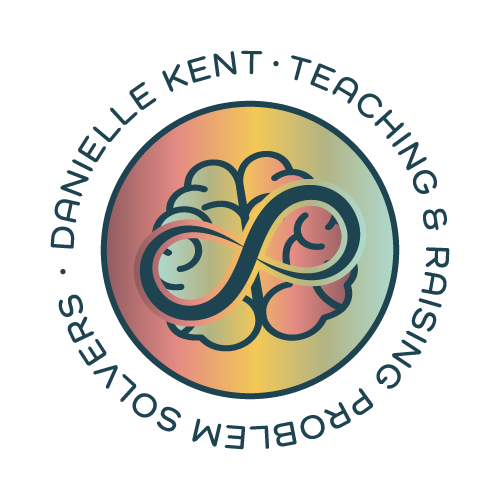Episode 27: Where do we start as adults with kids who are dysregulated?
Hello, everyone! Welcome to another episode of the Teaching and Raising Problem Solvers podcast.
Today’s episode is a reflection about the quote from the last episode (#26), with tangible tips and takeaways.
The quote I shared from the last episode is the following, from Dr. Mona Delahooke’s book, Beyond Behaviors:
When we fail to recognize that many behaviors represent the body’s response to stress, not intentional misbehavior, we expend effort on techniques designed to help children logically connect their thoughts, emotions, and behaviors– when they simply can’t yet.
Today’s takeaway, today’s tangible action step for you is somewhat similar to the one from the last quote for reflection. It’s that being able to look at a behavior and see the stressor that could be behind it, or understanding the stress response, starts with becoming aware of what thoughts we are having when a child is exhibiting a behavior.
This is why I came up with that COAST acronym:
C - Check on yourself (your own thoughts and feelings)
O - Observe
A - Acknowledge
S - Support
T - Transition and teach
I want to focus pretty much exclusively on the “C” here, which is, “check on your own thoughts and feelings.”
To the adults listening to this, no matter how old you are: although the research and work of all the foundational authors in this area (Dr. Dan Siegel, Dr. Mona Delahooke, Dr. Stuart Shenker) has existed for a while, it has only hit the mainstream in the last 10 years or so. The adults who are listening to this grew up in a generation that was behavior-driven, based on Skinner’s ideas that we did things to get rewarded and we avoided things that we thought we would get punished for. Now that we understand the brain and self-regulation a little more, we know that this speaks to only a layer of the truth about what was happening.
But because that is deeply ingrained in us, when kids are having a hard time– and note my careful language there, when kids are having a hard time (vs. giving us a hard time), some of that old thinking that we grew up with is probably still circulating somewhere in your thought patterns. And often, because we are adults in an authoritative role in some way (whether that’s a parent, a teacher, a professional in a school, a grandparent, or whatever it might be), there’s this previous thought that existed that if a child is “misbehaving” and you don’t get it to stop, that you are not in control. I’m going to name the thing, because that is very much what adults think. That viewpoint still very much permeates the culture in our educational system. And this is not speaking for educators, because the majority of the educators I know now are investing in learning about relationships and self-regulation. But this is part of the teachings we got from adults when we were younger–that behaviors were bad, that you’re naughty if you’re misbehaving, that you really just wanted to be obedient and compliant because that was the best way to be included. But a lot of that language still permeates our thought patterns when we are experiencing or working with a child who is dysregulated.
So the first step to being able to truly see and analyze a stress response, as a team or as an individual, is to be aware that it’s a stress response. This means that we are able to be in top-down thinking mode, to say, “Okay, what’s happening for you here?” And that’s why I have a previous podcast called, “That’s what’s happening to you, or for you.” That’s why I love the book, What Happened to You?
That ability to think and to be curious is a top-down skill. It is a cortex-driven skill. If we ourselves are dysregulated, anxious and frustrated, we cannot analyze, or we cannot support a child to analyze their behavior as a stress response. If we are in a stress response ourselves, our brain is busy protecting itself.
So the fastest way is to start practicing some of that forward thinking, practicing what it will feel like in your body when your child is dysregulated, or when a child is dysregulated–thinking about what that feels like in your body, or what thought patterns you have, and starting to become aware of that as it’s happening, so that then we can start to shift some of that. That is the most powerful way to start.
We can only make progress if we are aware of what is happening for us, in the moment, when kids are dysregulated. And I want to say that when anybody else around you is dysregulated, it is normal for your brain to start to become a little bit dysregulated because your brain has the desire to protect itself. Any threat, whether it’s coming from a tiger or a 5-year-old child who has flopped on the floor, is detected as a threat. So your brain is going to fire the alarm to say, “Hey, risk! There’s a risk here. We should mobilize!” And that’s when our body starts to become heightened; we become anxious, whatever happens for us.
That process is a normal process. But we can intercept it. We can recognize that we are the adults in the situation, and that our kids need us to help level out their regulation seesaw. A lot of the kids who are struggling cannot level out by themselves in a healthy way without the help of a regulated adult. So our responsibility becomes centering our own regulation, so we can then serve that role.
All right, everybody! I’m going to wrap up another episode of the Teaching and Raising Problem Solvers podcast, and I’ll talk to you next time.
